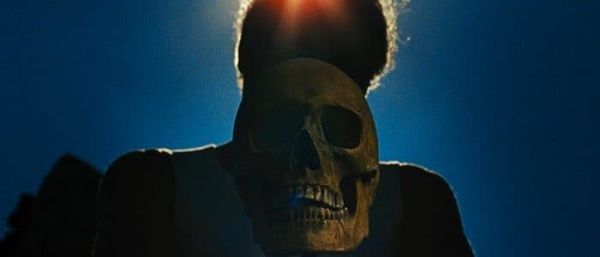Eye For Film >> Movies >> Let The Corpses Tan (2017) Film Review
Let The Corpses Tan
Reviewed by: Jennie Kermode

If you've seen Hélène Cattet and Bruno Forzani's previous collaborations, psychodrama Amer and missing person mystery The Strange Colour Of Your Body's Tears, you will have a clear idea what to expect from Let The Corpses Tan, and whilst you may find it to be more of the same in some ways, there's no disputing that what the two do, they do brilliantly. If you haven't seen either of those films, you are likely to find this one deeply disorientating and either love or loathe it - what you won't do is forget it.
The first thing to understand about this film (and the duo's work in general) is that the plot is not terribly important - it's just a skeleton on which to drape visual and psychosexual ideas. Here, what story there is follows a group of thieves fresh from a heist who hole up in a partially ruined castle owned by a writer and his artist lover, with whom one of them is acquainted. It ought to be a simple business but, in accordance with the laws of cinema, matters are complicated by betrayal, jealousy, the presence of other guests and the arrival of two police officers, who stumble onto the scene with no back-up and no plan. As allegiances are broken and people find themselves uncertain who they can trust, a prolonged and messy shoot-out develops.

Brutal though much of the action is, it's complicated by the fact that we are not just privy to what happens to the characters but also what goes on inside their heads. Under the hot sun that beats down on the rocky island where the castle is located, strange hallucinations occur and people often behave in ways more consistent with desire than reason. When thick, black night falls, the shape of the castle seems to subtly alter and the characters scuttle around like rats in a maze, but the intense erotic character of the location remains, threatening to smother their petty objectives and lead them into deadly peril.
The characters are clad - at least to begin with - in ugly Seventies-style clothes worn with such confidence that they inspire awe. The camera moves in close on bronzed flesh, showing us the pores, the wrinkles, taking pride in them; for all that the characters are thinly drawn, it never lets us forget that bodies are inhabited by people and it revels in their imperfection in a manner that complements the story perfectly. Whilst Cattet and Forzani draw heavily on the iconography of the classic western (even reusing music by Ennio Morricone, to delicious effect), the film also owes a debt to their origins in giallo, and there is much here that is strikingly original. Not every risky idea works, but where they are successful, the results are dazzling.
Despite all this brilliance, the film feels overlong and some sequences become trying. It's not helped by the fact that, beyond feeling vague sympathy for the innocents caught up in this catastrophe, we really don't have anyone to root for. That said, it demonstrates that its creators can successfully reach out into new areas, and if you like what you see, you'll be left longing for their next piece of work.
Reviewed on: 02 Jan 2019
















